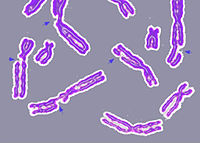
Photo from wikipedia
The therapeutic efficacy of histone deacetylase inhibitors (HDACi) for hematologic malignancies and solid tumors is attributed to their ability to remodel chromatin, normalize dysregulated gene expression, and inhibit repair of… Click to show full abstract
The therapeutic efficacy of histone deacetylase inhibitors (HDACi) for hematologic malignancies and solid tumors is attributed to their ability to remodel chromatin, normalize dysregulated gene expression, and inhibit repair of damaged DNA. Studies on the interactions of HDACi with PARP inhibitors in hematologic cancers are limited, especially when combined with chemotherapeutic agents. Exposure of hematologic cancer cell lines and patient-derived cell samples to various HDACi resulted in a significant caspase-independent inhibition of protein PARylation, mainly catalyzed by PARP1. HDACi affected the expression of PARP1 at the transcription and/or post-translation levels in a cell line-dependent manner. HDACi-mediated inhibition of PARylation correlated with decreased levels and phosphorylation of major proteins involved in DNA repair. Combination of HDAC and PARP1 inhibitors provided synergistic cytotoxicity, which was further enhanced when combined with a chemotherapeutic regimen containing gemcitabine, busulfan and melphalan as observed in lymphoma cell lines. Our results indicate that the anti-tumor efficacy of HDACi is partly due to down-regulation of PARylation, which negatively affects the status of DNA repair proteins. This repair inhibition, combined with the high levels of oxidative and DNA replication stress characteristic of cancer cells, could have conferred these hematologic cancer cells not only with a high sensitivity to HDACi but also with a heightened dependence on PARP and therefore with extreme sensitivity to combined HDACi/PARPi treatment and, by extension, to their combination with conventional DNA-damaging chemotherapeutic agents. The observed synergism of these drugs could have a major significance in improving treatment of these cancers.
Journal Title: Oncotarget
Year Published: 2022
Link to full text (if available)
Share on Social Media: Sign Up to like & get
recommendations!